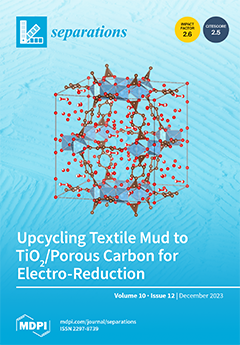We analyzed ten pulses (the dried seeds of legumes), i.e., baby lima beans, black beans, black-eyed peas, butter beans, cranberry beans, garbanzo beans, green split peas, lentils, navy beans, and pinto beans, using three-dimensional liquid chromatography (3D-LC) with parallel second dimensions, LC ×
[...] Read more.
We analyzed ten pulses (the dried seeds of legumes), i.e., baby lima beans, black beans, black-eyed peas, butter beans, cranberry beans, garbanzo beans, green split peas, lentils, navy beans, and pinto beans, using three-dimensional liquid chromatography (3D-LC) with parallel second dimensions, LC × (LC + LC). We combined non-aqueous reversed-phase (NARP) chromatography as the first dimension separation,
1D, with argentation UHPLC for separation based on degree and location of unsaturation in the first second dimension,
2D(1), and multi-cycle NARP-UHPLC in the second second dimension,
2D(2). Pulses contained 1.9% to 2.7% lipids, except garbanzo beans, which contained 6.2% lipids. High-resolution, accurate-mass (HRAM) orbitrap mass spectrometry (MS) was used to perform lipidomic analysis of the
2D(2) and percent relative quantification, showing that the most abundant average triacylglycerol (TAG) molecular species across all pulses were PLL at 10.67% and PLLn at 10.45%. Common beans (
Phaseolus vulgaris) were clustered together using principal component analysis (PCA), showing the highest levels of linolenic acid, C18:3, in molecular species such as PLnLn, LLnLn, and OLLn, with palmitic (P), C16:0, linoleic (L), 18:2, linolenic (Ln), 18:3, and oleic (O), 18:1, FAs. Calibration curves derived from interweaved sets of regioisomer standards allowed the absolute quantification of 1,2- and 1,3-regioisomers for a subset of TAGs.
Full article





